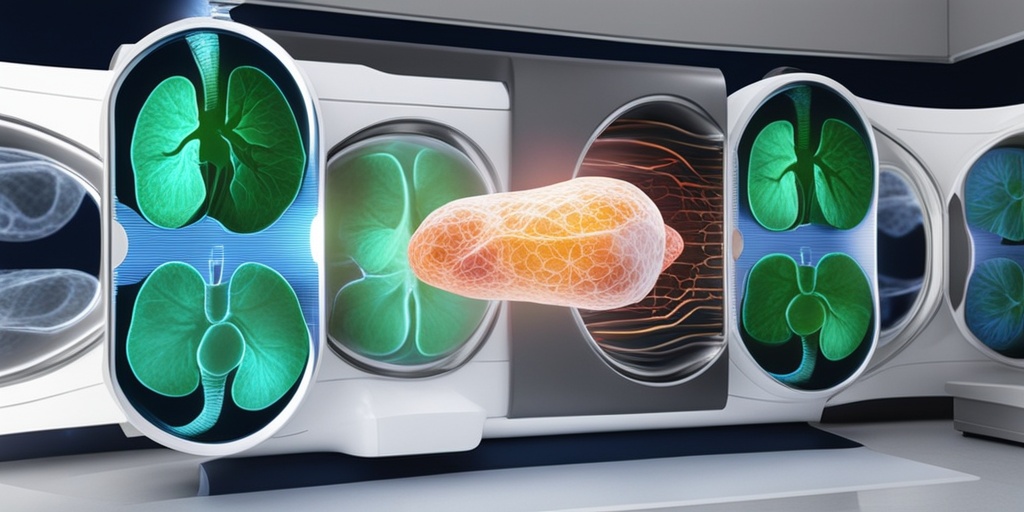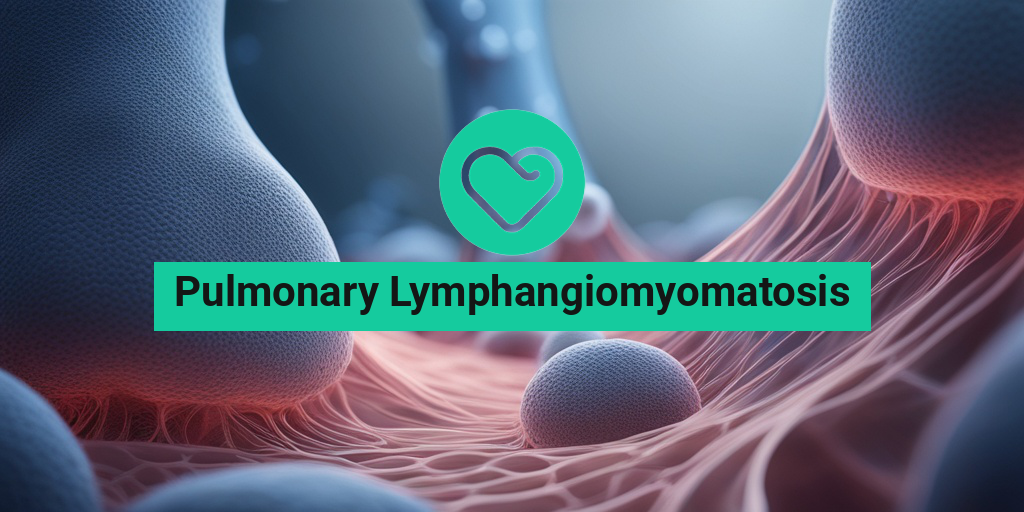“`html
What Is Pulmonary Lymphangiomyomatosis?
Pulmonary Lymphangiomyomatosis (LAM) is a rare and progressive lung disease that primarily affects women, particularly those of childbearing age. It is characterized by the abnormal growth of smooth muscle cells in the lungs and lymphatic system, leading to the formation of cysts and the obstruction of lymphatic vessels. This condition can significantly impair lung function and overall respiratory health.
Understanding the Mechanism of LAM
The exact cause of pulmonary lymphangiomyomatosis remains unclear, but it is often associated with a genetic mutation in the TSC2 gene, which is linked to tuberous sclerosis complex (TSC). This genetic predisposition leads to the proliferation of atypical smooth muscle cells, which can invade lung tissue and disrupt normal lung architecture.
Who Is Affected?
While LAM can occur in both men and women, it predominantly affects women, with most cases diagnosed between the ages of 20 and 40. The disease is rare, with an estimated prevalence of 1 in 400,000 women. However, it can also occur in individuals with TSC, where the incidence is significantly higher.
Diagnosis of Pulmonary Lymphangiomyomatosis
Diagnosing pulmonary lymphangiomyomatosis can be challenging due to its rarity and the overlap of symptoms with other respiratory conditions. Common diagnostic methods include:
- Imaging Studies: High-resolution computed tomography (HRCT) scans are crucial for identifying the characteristic cystic changes in the lungs.
- Lung Function Tests: These tests assess the extent of lung impairment and help in monitoring disease progression.
- Biopsy: In some cases, a lung biopsy may be performed to confirm the diagnosis by examining the tissue for abnormal smooth muscle cells.
Symptoms of Pulmonary Lymphangiomyomatosis
The symptoms of pulmonary lymphangiomyomatosis can vary widely among individuals, and they often develop gradually. Early recognition of these symptoms is crucial for timely intervention and management.
Common Symptoms
Individuals with LAM may experience a range of symptoms, including:
- Shortness of Breath: This is often the most prominent symptom, initially occurring during physical activity and eventually at rest as the disease progresses.
- Chronic Cough: A persistent cough that may produce sputum can be indicative of lung involvement.
- Chest Pain: Some patients report discomfort or pain in the chest, which can be attributed to lung expansion issues.
- Fatigue: Generalized fatigue and decreased exercise tolerance are common as lung function declines.
Complications Associated with LAM
As pulmonary lymphangiomyomatosis progresses, it can lead to several complications, including:
- Pneumothorax: The formation of air pockets in the pleural space can occur due to the rupture of cysts, leading to lung collapse.
- Respiratory Failure: Severe impairment of lung function may necessitate supplemental oxygen or even lung transplantation in advanced cases.
- Kidney Tumors: Women with LAM are at an increased risk of developing angiomyolipomas, benign tumors in the kidneys.
When to Seek Medical Attention
If you or someone you know is experiencing symptoms consistent with pulmonary lymphangiomyomatosis, it is essential to seek medical attention promptly. Early diagnosis and management can significantly improve quality of life and slow disease progression.
For more information and resources on pulmonary lymphangiomyomatosis, consider visiting Yesil Health AI, where you can find evidence-based health answers tailored to your needs. 🌟
“`

“`html
Causes and Risk Factors
Pulmonary Lymphangiomyomatosis (LAM) is a rare lung disease that primarily affects women, particularly those of childbearing age. Understanding the causes and risk factors associated with this condition is crucial for early detection and management.
Genetic Factors
One of the primary causes of pulmonary lymphangiomyomatosis is a genetic mutation. Most cases are linked to mutations in the TSC2 gene, which is associated with tuberous sclerosis complex (TSC). TSC is a genetic disorder that can lead to the growth of non-cancerous tumors in various organs, including the lungs. Women with TSC are at a higher risk of developing LAM.
Hormonal Influences
Hormones may also play a significant role in the development of LAM. The disease predominantly affects women, and many patients report that their symptoms worsen during pregnancy or with hormonal changes. This suggests that estrogen may influence the progression of the disease, although the exact mechanism remains unclear.
Environmental Factors
While the primary cause of pulmonary lymphangiomyomatosis is genetic, some studies suggest that environmental factors may contribute to its onset. Exposure to certain toxins or pollutants could potentially trigger or exacerbate the condition, although more research is needed to establish a definitive link.
Risk Factors
- Gender: LAM is significantly more common in women than men.
- Age: Most cases are diagnosed in women between the ages of 20 and 40.
- Family History: A family history of tuberous sclerosis or LAM increases the risk.
- Pregnancy: Women who have been pregnant may experience a worsening of symptoms.
Understanding these causes and risk factors can help in recognizing the signs of pulmonary lymphangiomyomatosis early, leading to better management and treatment outcomes. 🌼
Diagnosis of Pulmonary Lymphangiomyomatosis
Diagnosing pulmonary lymphangiomyomatosis can be challenging due to its rarity and the overlap of symptoms with other lung diseases. A comprehensive approach is essential for accurate diagnosis.
Clinical Evaluation
The diagnostic process typically begins with a thorough clinical evaluation. Physicians will take a detailed medical history and perform a physical examination. Symptoms such as shortness of breath, cough, and chest pain are common in LAM patients and will be carefully assessed.
Imaging Studies
Imaging studies play a crucial role in diagnosing pulmonary lymphangiomyomatosis. The following imaging techniques are commonly used:
- Chest X-ray: This initial imaging test can reveal abnormalities in lung structure.
- CT Scan: A high-resolution CT scan of the chest is more definitive and can show characteristic findings such as cysts and lymphatic abnormalities.
Lung Function Tests
Lung function tests are essential for assessing the impact of LAM on respiratory health. These tests measure lung capacity and airflow, helping to determine the severity of the disease. Patients may experience reduced lung capacity, which can be quantified in terms of percentages, such as pulmonary fibrosis 50 lung capacity or pulmonary fibrosis 40 lung capacity.
Biopsy and Pathology
In some cases, a lung biopsy may be necessary to confirm the diagnosis. This involves taking a small sample of lung tissue for examination under a microscope. Pathology outlines can help identify the characteristic smooth muscle proliferation associated with LAM.
Genetic Testing
For patients with a family history of tuberous sclerosis or LAM, genetic testing may be recommended. Identifying mutations in the TSC2 gene can provide valuable information for diagnosis and management.
In conclusion, the diagnosis of pulmonary lymphangiomyomatosis involves a combination of clinical evaluation, imaging studies, lung function tests, and, when necessary, biopsy and genetic testing. Early diagnosis is key to managing this complex condition effectively. 🩺
“`

“`html
Treatment Options Available
Pulmonary Lymphangiomyomatosis (LAM) is a rare lung disease that primarily affects women, characterized by the abnormal growth of smooth muscle cells in the lungs and lymphatic system. While there is currently no cure for LAM, several treatment options can help manage symptoms and improve quality of life. Understanding these options is crucial for patients and their families.
Medications
Medications play a vital role in managing the symptoms of pulmonary lymphangiomyomatosis. Here are some commonly used treatments:
- Sirolimus (Rapamune): This medication is an immunosuppressant that has shown promise in slowing the progression of LAM. It works by inhibiting the growth of smooth muscle cells, which can help improve lung function and reduce the size of lymphatic cysts.
- Bronchodilators: These medications help open the airways, making it easier to breathe. They are often prescribed to alleviate symptoms of shortness of breath.
- Oxygen Therapy: For patients experiencing low oxygen levels, supplemental oxygen can be beneficial. This therapy helps maintain adequate oxygen saturation in the blood, improving overall well-being.
Interventional Procedures
In some cases, interventional procedures may be necessary to manage complications associated with LAM:
- Thoracentesis: This procedure involves the removal of excess fluid from the pleural space, which can relieve pressure on the lungs and improve breathing.
- Chest Tube Placement: For patients with recurrent pleural effusions, a chest tube may be placed to continuously drain fluid and prevent buildup.
Lung Transplantation
In severe cases of pulmonary lymphangiomyomatosis, lung transplantation may be considered. This option is typically reserved for patients with significant lung impairment and is evaluated on a case-by-case basis. The decision to pursue transplantation involves a thorough assessment of the patient’s overall health and lung function.
Supportive Care
In addition to medical treatments, supportive care is essential for managing pulmonary lymphangiomyomatosis:
- Pulmonary Rehabilitation: This program includes exercise training, education, and support to help patients improve their physical condition and manage symptoms.
- Nutritional Support: Maintaining a balanced diet is crucial for overall health. Consulting with a nutritionist can help patients develop a meal plan that meets their needs.
- Psychological Support: Living with a chronic illness can be challenging. Counseling or support groups can provide emotional support and coping strategies.
Living with Pulmonary Lymphangiomyomatosis
Living with pulmonary lymphangiomyomatosis can be a daunting experience, but with the right strategies and support, patients can lead fulfilling lives. Here are some tips for managing daily life with this condition.
Understanding Your Condition
Knowledge is power. Understanding the nature of pulmonary lymphangiomyomatosis, its symptoms, and treatment options can empower patients to take an active role in their healthcare. Regular consultations with healthcare providers and staying informed about the latest research can help patients make informed decisions.
Building a Support Network
Connecting with others who have LAM can provide invaluable support. Consider joining support groups or online communities where patients can share experiences, advice, and encouragement. Family and friends also play a crucial role in providing emotional support, so keeping them informed about your condition can foster understanding and compassion.
Managing Symptoms
Effective symptom management is key to maintaining a good quality of life. Here are some strategies:
- Regular Exercise: Engaging in low-impact exercises, such as walking or swimming, can help improve lung function and overall fitness. Always consult with a healthcare provider before starting any exercise program.
- Breathing Techniques: Learning and practicing breathing exercises can help alleviate shortness of breath and improve lung capacity.
- Stress Management: Techniques such as yoga, meditation, and mindfulness can help reduce stress and improve mental well-being.
Monitoring Your Health
Regular check-ups and monitoring are essential for managing pulmonary lymphangiomyomatosis. Keeping track of symptoms, medication adherence, and any changes in health can help healthcare providers make necessary adjustments to treatment plans. Utilizing tools like symptom diaries or health apps can aid in this process.
In conclusion, while living with pulmonary lymphangiomyomatosis presents challenges, understanding treatment options and implementing effective management strategies can significantly enhance quality of life. Remember, you are not alone in this journey! 🌈
“`

“`html
Complications and Prognosis
Pulmonary Lymphangiomyomatosis (LAM) is a rare lung disease that primarily affects women, particularly those of childbearing age. It is characterized by the abnormal proliferation of smooth muscle-like cells in the lungs and lymphatic system, leading to various complications. Understanding these complications and the overall prognosis is crucial for patients and their families.
Common Complications of Pulmonary Lymphangiomyomatosis
Patients with LAM may experience a range of complications that can significantly impact their quality of life. Some of the most common complications include:
- Pneumothorax: This is a condition where air leaks into the space between the lung and chest wall, causing the lung to collapse. It is one of the most frequent complications associated with LAM and can lead to sudden chest pain and difficulty breathing.
- Chylothorax: This occurs when lymphatic fluid accumulates in the pleural space, often resulting in shortness of breath and chest discomfort. It can be a challenging complication to manage.
- Respiratory Failure: As the disease progresses, lung function may decline, leading to respiratory failure. This condition requires immediate medical attention and may necessitate supplemental oxygen or mechanical ventilation.
- Kidney Involvement: In some cases, LAM can affect the kidneys, leading to the development of angiomyolipomas, which are benign tumors. While these tumors are usually asymptomatic, they can cause complications if they grow large or bleed.
Prognosis for Patients with Pulmonary Lymphangiomyomatosis
The prognosis for individuals diagnosed with LAM can vary widely based on several factors, including the severity of the disease and the presence of complications. Here are some key points regarding prognosis:
- Life Expectancy: While LAM is a progressive disease, many patients can live for years with appropriate management. Some studies suggest that the median survival rate is around 10 years post-diagnosis, but this can vary significantly.
- Lung Function: Regular monitoring of lung function is essential. Patients may experience a gradual decline in lung capacity, with some studies indicating that individuals with pulmonary fibrosis may have a lung capacity of around 40-50% over time.
- Quality of Life: With advancements in treatment and supportive care, many patients can maintain a good quality of life. Lifestyle modifications, such as avoiding smoking and engaging in pulmonary rehabilitation, can also help improve outcomes.
Research and Future Directions
Research into Pulmonary Lymphangiomyomatosis is ongoing, with scientists and healthcare professionals striving to better understand the disease and develop effective treatments. Here are some of the promising areas of research and future directions:
Genetic and Molecular Studies
Recent studies have focused on the genetic mutations associated with LAM, particularly the TSC2 gene. Understanding the genetic basis of the disease could lead to targeted therapies that address the underlying causes of LAM. Researchers are also exploring the role of hormones in the progression of the disease, as LAM predominantly affects women.
Novel Therapeutic Approaches
Current treatments for LAM primarily focus on managing symptoms and complications. However, new therapeutic options are being investigated:
- Sirolimus: This medication, originally used to prevent organ transplant rejection, has shown promise in stabilizing lung function in LAM patients. Ongoing clinical trials are assessing its long-term efficacy and safety.
- Targeted Therapies: Researchers are exploring the potential of targeted therapies that inhibit the pathways involved in the abnormal cell growth characteristic of LAM. These therapies could offer more effective treatment options in the future.
Improving Diagnosis and Management
Advancements in imaging techniques, such as high-resolution computed tomography (HRCT), are enhancing the ability to diagnose LAM earlier and more accurately. Improved diagnostic tools can lead to timely interventions, which may help mitigate complications and improve patient outcomes.
As research continues, the hope is to develop comprehensive management strategies that not only address the symptoms of Pulmonary Lymphangiomyomatosis but also target the disease’s underlying mechanisms. This could significantly improve the prognosis and quality of life for those affected by this challenging condition. 🌟
“`

“`html
Frequently Asked Questions about Pulmonary Lymphangiomyomatosis
What is Pulmonary Lymphangiomyomatosis?
Pulmonary Lymphangiomyomatosis (LAM) is a rare lung disease characterized by the abnormal growth of smooth muscle cells in the lungs and lymphatic system. This condition primarily affects women and can lead to progressive lung damage and respiratory issues.
What are the symptoms of Pulmonary Lymphangiomyomatosis?
- Shortness of breath, especially during physical activity
- Chronic cough
- Chest pain
- Fatigue
- Recurrent pneumothorax (collapsed lung)
How is Pulmonary Lymphangiomyomatosis diagnosed?
Diagnosis typically involves a combination of imaging studies, such as CT scans, and lung function tests. A biopsy may also be performed to confirm the presence of LAM cells.
What is the treatment for Pulmonary Lymphangiomyomatosis?
While there is no cure for Pulmonary Lymphangiomyomatosis, treatment options may include:
- Medications to manage symptoms
- Oxygen therapy
- Lung transplantation in severe cases
Can Pulmonary Lymphangiomyomatosis lead to other complications?
Yes, individuals with Pulmonary Lymphangiomyomatosis may experience complications such as pulmonary fibrosis, which can further reduce lung capacity and lead to additional respiratory issues.
Is Pulmonary Lymphangiomyomatosis hereditary?
In some cases, Pulmonary Lymphangiomyomatosis is associated with Tuberous Sclerosis Complex (TSC), a genetic disorder. However, not all cases of LAM are hereditary.
What lifestyle changes can help manage Pulmonary Lymphangiomyomatosis?
Patients are encouraged to:
- Engage in regular, low-impact exercise
- Maintain a healthy diet
- Avoid smoking and secondhand smoke
- Stay up to date with vaccinations to prevent respiratory infections
Where can I find support for Pulmonary Lymphangiomyomatosis?
Support groups and organizations dedicated to LAM can provide valuable resources and community support. Connecting with others who have similar experiences can be beneficial for emotional well-being.
What is the prognosis for someone with Pulmonary Lymphangiomyomatosis?
The prognosis varies among individuals. Some may experience a slow progression of the disease, while others may have a more rapid decline in lung function. Regular monitoring and appropriate medical care are essential for managing the condition.
“`




